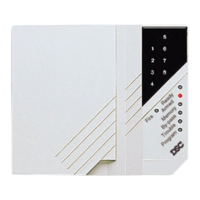15
[07] Reporting Codes for Closing
(Arming) with Access Codes 1 to 8
The reporting codes in sections [07] to [10] are used to
identify “Openings and Closings” (disarming and arming of
the system) by user access code.
After entering the section code [07], enter 9 two digit
reporting codes. The 9 reporting codes correspond to the
first 8 access codes which are programmed using the [✱][5]
command and then the partial closing code in last. When
the system is armed using one of the access codes, the
corresponding reporting code is transmitted.
When transmitting in any of the extended formats, (see
examples in section [05]), closing codes would be
programmed as follows. [C1], [C2], [C3], [C4], [C5], [C6],
[C7], [C8]........Where the first digit “HEX C” is one which is
used to represent a closing signal (this could be another
number depending on what is used at the monitoring
station) the 2nd digit represents the access code which was
used to arm the system.
The closing code transmission takes place after the exit
delay time. Therefore if the system is armed and
disarmed before the expiry of the exit time, no
transmission will take place.
Remember that the 1st access code is the Master Code and
that the 16th code may be the temporary or maid’s code.
The 16th access code can be converted to a normal code
by turning light 8 off in section [15].
When the system has been armed using “Quick Arm” [✱][0]
or “Auto-arm” (see [✱][6] “Keypad Commands”), the 1st
reporting code (reporting code for Master Code) will be
transmitted. The Master Code is required to enable or
disable these functions.
When the system is armed with one or more zones
bypassed (see [✱][1] command for zone bypassing), the
monitoring station can be notified by programming the
Partial Arm reporting in section [16]. Note that the partial
closing code is sent in tandem with the regular closing code
to identify it as a partial closing condition. If section [16] light
1 is on then the bypassed zones will be identified between
the partial closing and the closing code by sending their
alarm code transmissions.
[08] Reporting Codes for Closing
(Arming) with Access Codes 9 to 16
The Auto-arm Cancel code is described on page 10 under Auto-
arm Time of Day. See section [07] for programming information.
[09] Reporting Codes for Opening
(Disarming) with Access Codes 1 to 8
The 8 reporting codes correspond to the first 8 access
codes which are programmed using the [✱][5] command.
When the system is disarmed using one of the access
codes, the corresponding reporting code in this section is
transmitted.
See section [07] for an example of “Opening and Closing”
reporting code programming.
[10] Reporting Codes for Opening
(Disarming) with Access Codes 9 to 16
See section [09] for further information.
If the opening after alarm code is programmed, that code
will be transmitted to the monitoring station on opening if an
alarm occurred during the previous armed period. This
feature is useful for installations where openings and
closings are not reported normally but it is desired to have a
report to the monitoring station on opening if an alarm did
occur during the previous armed period. This feature allows
the monitoring station to know when the user is on the
premises and available to receive a report about alarms that
occurred while the system was closed.
[11] Reporting Codes for Priority
Alarms and Restorals
These reporting codes are used by the communicator to
transmit the following list of alarm and restoral conditions.
Use instructions in section [05] as a guide for programming.
See “Terminal Connections” section of manual for a
description of the operation of the Fire Zone and the
Auxiliary Input Zone. Section [30] contains options for
Auxiliary Input Zone.
• Fire Zone
• Auxiliary Input Zone
• Keypad Panic Alarm [P]
• Keypad Fire Alarm [F]
• Keypad Auxiliary Alarm [A]
• Fire Zone Restoral
• Auxiliary Input Zone Restoral
• Keypad Panic Restoral [P]
• Keypad Fire Restoral [F]
• Keypad Auxiliary Restoral [A]
12] Reporting Codes for Maintenance
Alarms
The reporting codes programmed in this section include the
periodic test reporting code (every 1 to 99 days) and trouble
conditions. The battery trouble reporting code will be sent
when the battery voltage drops below 11.3 volts. This
reporting code will also be sent because of a battery fuse
failure. The battery is tested under load every 4 minutes. The
AC failure trouble reporting code will be sent after the delay
time programmed in section [20]. This prevents
transmissions during temporary power failures. Auxiliary
power supply trouble reporting code is sent when the
auxiliary power supply fuse is blown. The bell circuit trouble
reporting code is sent when the bell circuit is open or the
fuse is blown. The fire zone trouble code is sent when the
fire zone becomes open circuit (E.O.L. resistor is
disconnected). The day zone trouble code is sent when any
zone defined as a day zone (see section [14]) goes open
when the system is disarmed. See [✱][2] Trouble Command
for additional description of trouble codes and
transmissions. The periodic test cycle time is set in section
[20] and reporting time of day is set in section [23].

